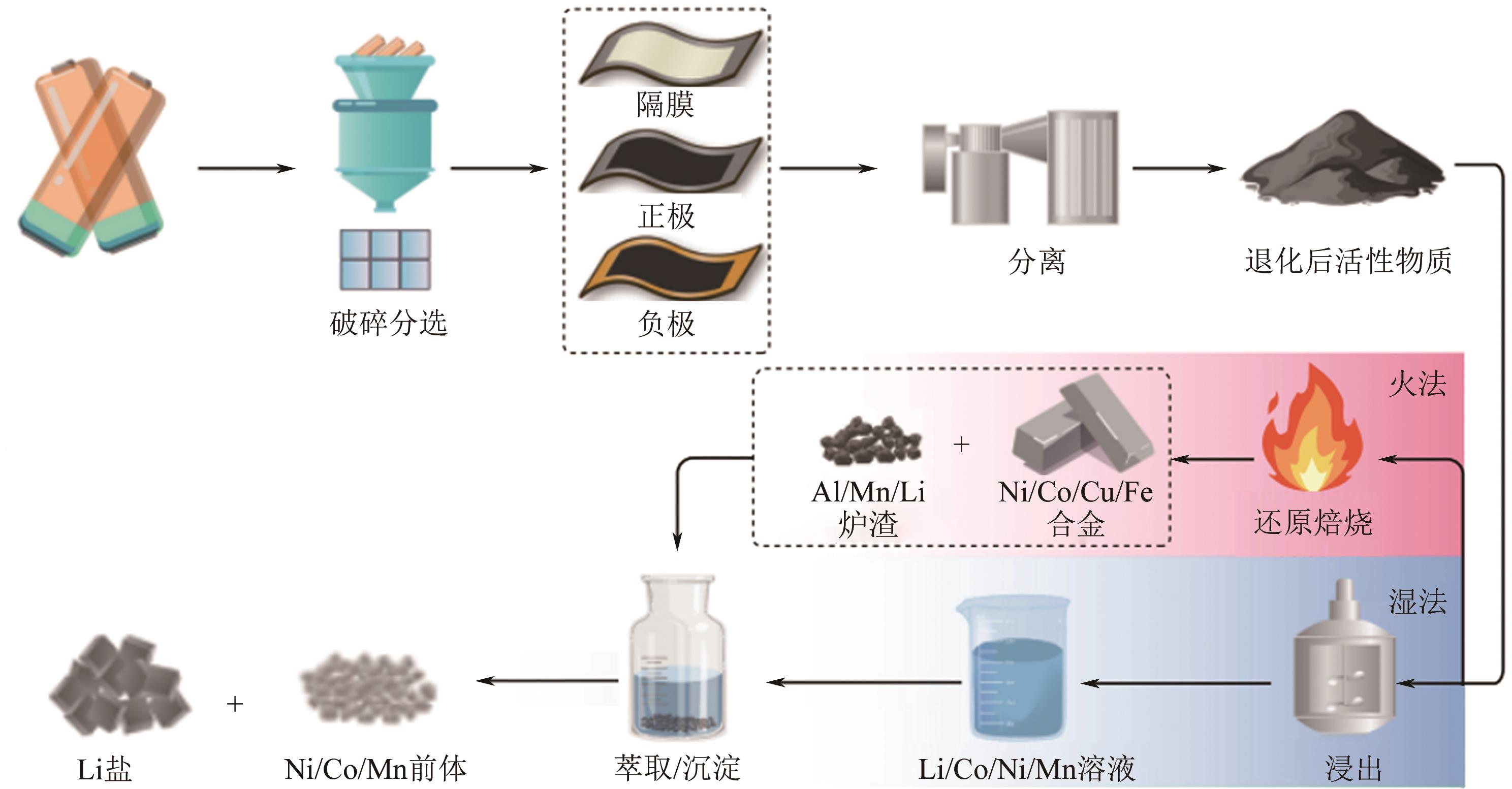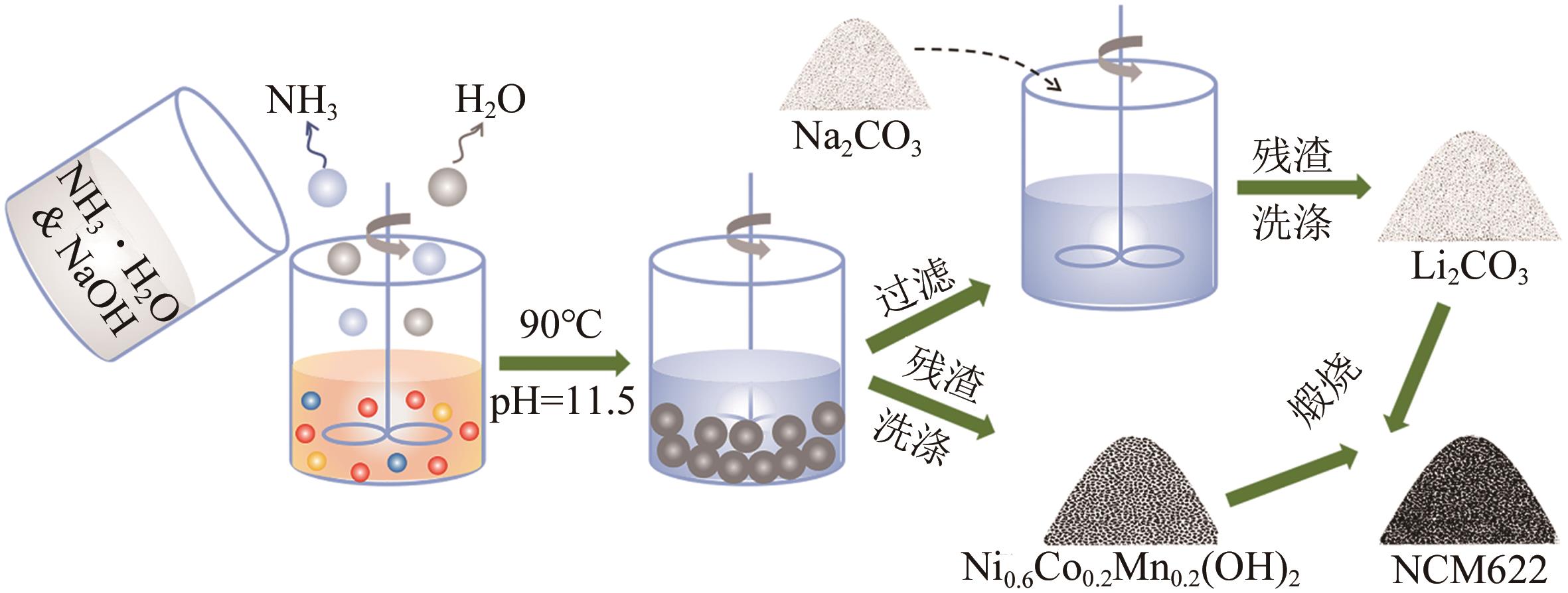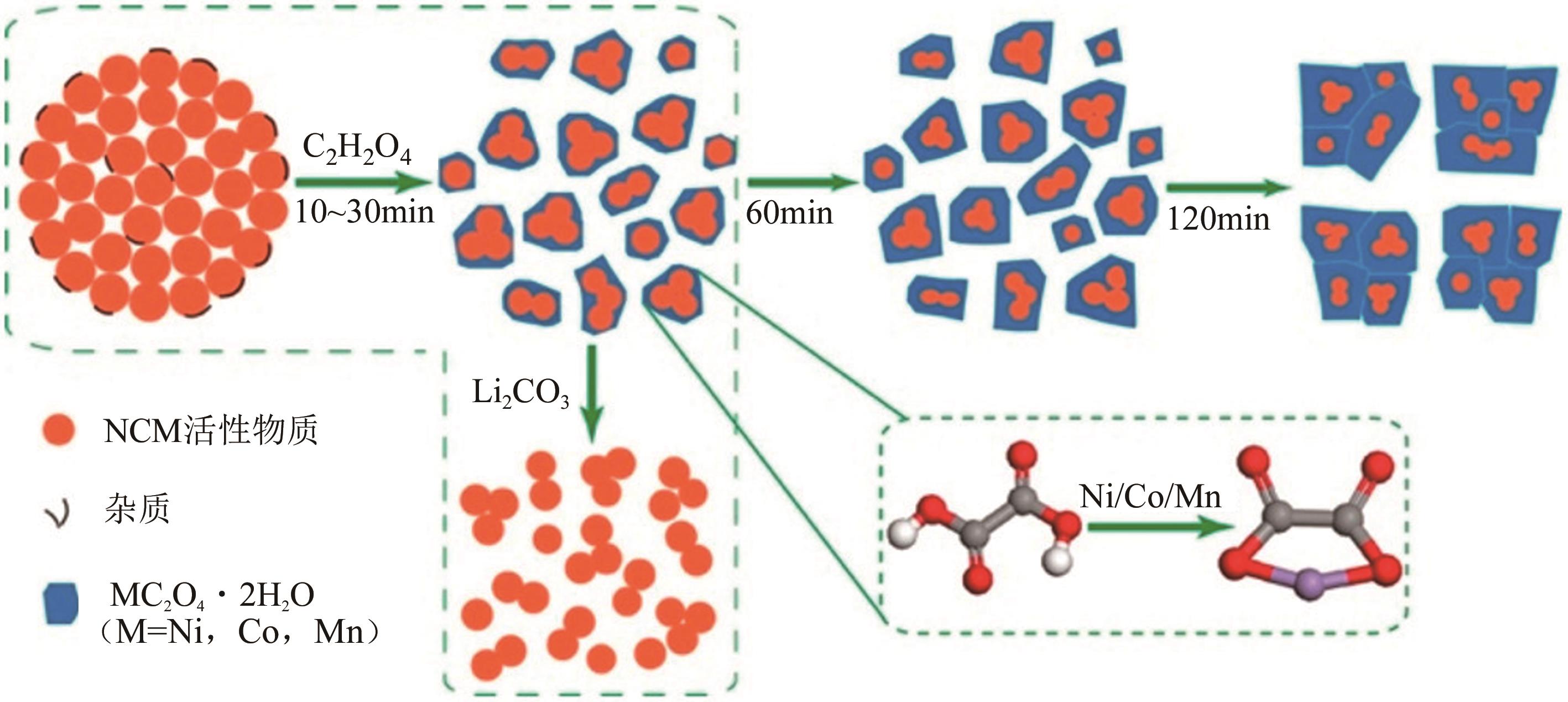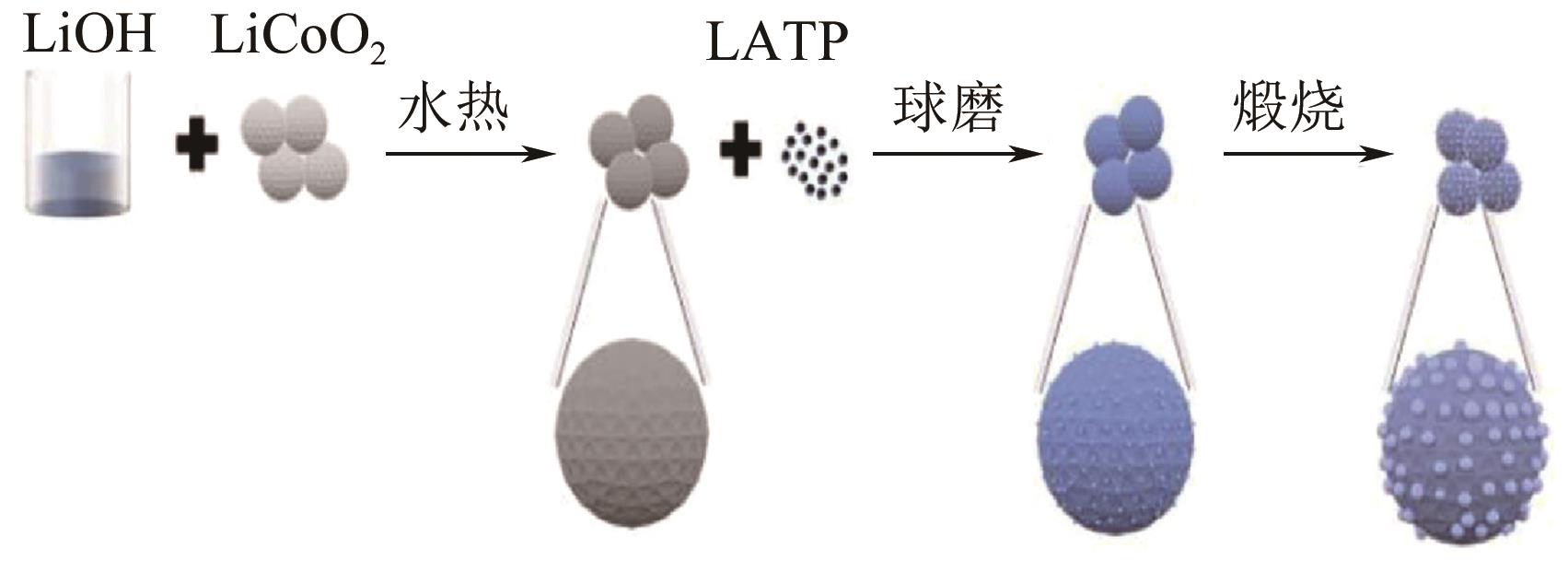化工进展 ›› 2024, Vol. 43 ›› Issue (9): 5207-5216.DOI: 10.16085/j.issn.1000-6613.2023-1356
• 资源与环境化工 • 上一篇
废旧锂离子电池正极材料直接再生技术研究进展
李红彦( ), 谢书涵, 张燕如, 王永净, 王永好, 吕源财, 林春香, 李小娟(
), 谢书涵, 张燕如, 王永净, 王永好, 吕源财, 林春香, 李小娟( )
)
- 福州大学环境与安全工程学院,福建 福州 350108
-
收稿日期:2023-08-08修回日期:2024-02-12出版日期:2024-09-15发布日期:2024-09-30 -
通讯作者:李小娟 -
作者简介:李红彦(1997—),女,硕士研究生,研究方向为废旧锂离子电池回收再生利用技术和过硫酸盐高级氧化技术。E-mail:976396213@qq.com。 -
基金资助:福建省自然科学基金面上项目(2022J01108);福州大学贵重仪器设备开放测试基金(2023T016)
Research progress on the direct regeneration technology for cathode materials from spent lithium-ion batteries
LI Hongyan( ), XIE Shuhan, ZHANG Yanru, WANG Yongjing, WANG Yonghao, LYU Yuancai, LIN Chunxiang, LI Xiaojuan(
), XIE Shuhan, ZHANG Yanru, WANG Yongjing, WANG Yonghao, LYU Yuancai, LIN Chunxiang, LI Xiaojuan( )
)
- College of Environment & Safety Engineering, Fuzhou University, Fuzhou 350108, Fujian, China
-
Received:2023-08-08Revised:2024-02-12Online:2024-09-15Published:2024-09-30 -
Contact:LI Xiaojuan
摘要:
随着锂离子电池(LIBs)需求量的急剧增长,必将产生大量废旧LIBs,如若处置不当,将带来严重的环境污染问题。废旧LIBs的正极材料中含有大量稀缺有价金属,对这些金属进行回收会产生环境和经济的双重效益。相较于传统的正极材料中金属组分的分离纯化回收技术,正极材料直接再生的策略因其具有工艺简单、能耗低、回收周期短、产品附加值高等优势而备受关注。本文综述了共沉淀法、溶胶-凝胶法、固相烧结法、水热法、离子热/熔盐法和电化学修复法6种废旧LIBs正极材料直接再生技术及其优缺点。其中共沉淀法和溶胶-凝胶法因其相对复杂的步骤、较高的设备要求和试剂成本,在工业化应用中具有一定的局限性;固相烧结法、水热法、离子热/熔盐法和电化学修复法因其便捷性和经济性,具有巨大的发展机会。同时展望了废旧LIBs正极材料直接再利用的前景和发展趋势,旨在为废旧LIBs回收领域研究提供参考。
中图分类号:
引用本文
李红彦, 谢书涵, 张燕如, 王永净, 王永好, 吕源财, 林春香, 李小娟. 废旧锂离子电池正极材料直接再生技术研究进展[J]. 化工进展, 2024, 43(9): 5207-5216.
LI Hongyan, XIE Shuhan, ZHANG Yanru, WANG Yongjing, WANG Yonghao, LYU Yuancai, LIN Chunxiang, LI Xiaojuan. Research progress on the direct regeneration technology for cathode materials from spent lithium-ion batteries[J]. Chemical Industry and Engineering Progress, 2024, 43(9): 5207-5216.
| 1 | ETACHERI Vinodkumar, MAROM Rotem, ELAZARI Ran, et al. Challenges in the development of advanced Li-ion batteries: A review[J]. Energy & Environmental Science, 2011, 4(9): 3243-3262. |
| 2 | XU Panpan, YANG Zhenzhen, YU Xiaolu, et al. Design and optimization of the direct recycling of spent Li-ion battery cathode materials[J]. ACS Sustainable Chemistry & Engineering, 2021, 9(12): 4543-4553. |
| 3 | MALLICK Sourav, PATEL Arjun, SUN Xiaoguang, et al. Low-cobalt active cathode materials for high-performance lithium-ion batteries: Synthesis and performance enhancement methods[J]. Journal of Materials Chemistry A, 2023, 11(8): 3789-3821. |
| 4 | ZHU Xiangdong, XIAO Jin, MAO Qiuyun, et al. A promising regeneration of waste carbon residue from spent Lithium-ion batteries via low-temperature fluorination roasting and water leaching[J]. Chemical Engineering Journal, 2022, 430: 132703. |
| 5 | MEEGODA Jay N, MALLADI Sarvagna, ZAYAS Isabel C. End-of-life management of electric vehicle lithium-ion batteries in the United States[J]. Clean Technologies, 2022, 4(4): 1162-1174. |
| 6 | HE Kai, ZHANG Zhiyuan, ZHANG Fushen. A green process for phosphorus recovery from spent LiFePO4 batteries by transformation of delithiated LiFePO4 crystal into NaFeS2 [J]. Journal of Hazardous Materials, 2020, 395: 122614. |
| 7 | ZHAO Yanlan, YUAN Xingzhong, JIANG Longbo, et al. Regeneration and reutilization of cathode materials from spent lithium-ion batteries[J]. Chemical Engineering Journal, 2020, 383: 123089. |
| 8 | NEUMANN Jonas, PETRANIKOVA Martina, MEEUS Marcel, et al. Recycling of lithium-ion batteries—Current state of the art, circular economy, and next generation recycling[J]. Advanced Energy Materials, 2022, 12(17): 2102917. |
| 9 | YANG Yue, OKONKWO Emenike G, HUANG Guoyong, et al. On the sustainability of lithium ion battery industry—A review and perspective[J]. Energy Storage Materials, 2021, 36: 186-212. |
| 10 | LAROUCHE François, TEDJAR Farouk, AMOUZEGAR Kamyab, et al. Progress and status of hydrometallurgical and direct recycling of Li-ion batteries and beyond[J]. Materials, 2020, 13(3): 801. |
| 11 | NATARAJAN Subramanian, ARAVINDAN Vanchiappan. Burgeoning prospects of spent lithium-ion batteries in multifarious applications[J]. Advanced Energy Materials, 2018, 8(33): 1802303. |
| 12 | HARPER Gavin, SOMMERVILLE Roberto, KENDRICK Emma, et al. Recycling lithium-ion batteries from electric vehicles[J]. Nature, 2019, 575(7781): 75-86. |
| 13 | VIECELI Nathália, CASASOLA Raquel, LOMBARDO Gabriele, et al. Hydrometallurgical recycling of EV lithium-ion batteries: Effects of incineration on the leaching efficiency of metals using sulfuric acid[J]. Waste Management, 2021, 125: 192-203. |
| 14 | YANG Yue, SUN Wei, BU Yongjie, et al. Recovering valuable metals from spent lithium ion battery via a combination of reduction thermal treatment and facile acid leaching[J]. ACS Sustainable Chemistry & Engineering, 2018, 6(8): 10445-10453. |
| 15 | WANG Junxiong, ZHANG Qi, SHENG Jinzhi, et al. Direct and green repairing of degraded LiCoO2 for reuse in lithium-ion batteries[J]. National Science Review, 2022, 9(8): nwac097. |
| 16 | 唐迪, 王俊雄, 陈稳, 等. 退役锂离子电池正极材料直接回收的研究现状和展望[J]. 无机盐工业, 2023, 55(1): 15-25. |
| TANG Di, WANG Junxiong, CHEN Wen, et al. Research status and prospect on direct regeneration of cathode materials from retired lithium-ion batteries[J]. Inorganic Chemicals Industry, 2023, 55(1): 15-25. | |
| 17 | VIECELI Nathália, NOGUEIRA Carlos A, Carlos GUIMARÃES, et al. Hydrometallurgical recycling of lithium-ion batteries by reductive leaching with sodium metabisulphite[J]. Waste Management, 2018, 71: 350-361. |
| 18 | LEI Shuya, CAO Yang, CAO Xuefeng, et al. Separation of lithium and transition metals from leachate of spent lithium-ion batteries by solvent extraction method with Versatic 10[J]. Separation and Purification Technology, 2020, 250: 117258. |
| 19 | YANG Yue, SONG Shaole, JIANG Feng, et al. Short process for regenerating Mn-rich cathode material with high voltage from mixed-type spent cathode materials via a facile approach[J]. Journal of Cleaner Production, 2018, 186: 123-130. |
| 20 | 伍德佑, 刘志强, 饶帅, 等. 废旧磷酸铁锂电池正极材料回收利用技术的研究进展[J]. 有色金属(冶炼部分), 2020(10): 70-78. |
| WU Deyou, LIU Zhiqiang, RAO Shuai, et al. Research progress in recycling technology of cathode materials for spent lithium iron phosphate batteries[J]. Nonferrous Metals (Extractive Metallurgy), 2020(10): 70-78. | |
| 21 | SLOOP Steve E, CRANDON Lauren, ALLEN Marshall, et al. Cathode healing methods for recycling of lithium-ion batteries[J]. Sustainable Materials and Technologies, 2019, 22: e00113. |
| 22 | 王皓逸, 邹昱凌, 孟奇, 等. 退役三元锂离子电池正极材料高效清洁回收技术研究进展[J]. 人工晶体学报, 2021, 50(6): 1158-1169. |
| WANG Haoyi, ZOU Yuling, MENG Qi, et al. Research progress on efficient and clean recycling technology of spent ternary lithium battery cathode materials[J]. Journal of Synthetic Crystals, 2021, 50(6): 1158-1169. | |
| 23 | TANG Yiqi, QU Xin, ZHANG Beilei, et al. Recycling of spent lithium nickel cobalt manganese oxides via a low-temperature ammonium sulfation roasting approach[J]. Journal of Cleaner Production, 2021, 279: 123633. |
| 24 | WANG Dapeng, BELHAROUAK Ilias, ORTEGA Luis H, et al. Synthesis of high capacity cathodes for lithium-ion batteries by morphology-tailored hydroxide co-precipitation[J]. Journal of Power Sources, 2015, 274: 451-457. |
| 25 | ZHANG Xiaoxiao, BIAN Yifan, XU Siwenyu, et al. Innovative application of acid leaching to regenerate Li(Ni1/3Co1/3Mn1/3)O2 cathodes from spent lithium-ion batteries[J]. ACS Sustainable Chemistry & Engineering, 2018, 6(5): 5959-5968. |
| 26 | ZENG Xianlai, LI Jinhui, SHEN Bingyu. Novel approach to recover cobalt and lithium from spent lithium-ion battery using oxalic acid[J]. Journal of Hazardous Materials, 2015, 295: 112-118. |
| 27 | ZHANG Yannan, ZHANG Yiyong, ZHANG Yingjie, et al. Novel efficient regeneration of high-performance Li1.2[Mn0.56Ni0.16Co0.08]O2 cathode materials from spent LiMn2O4 batteries[J]. Journal of Alloys and Compounds, 2019, 783: 357-362. |
| 28 | DONG Shengde, ZHOU Yuan, Chunxi HAI, et al. Enhanced cathode performance: Mixed Al2O3 and LiAlO2 coating of Li1.2Ni0.13Co0.13Mn0.54O2 [J]. ACS Applied Materials & Interfaces, 2020, 12(34): 38153-38162. |
| 29 | LI Li, BIAN Yifan, ZHANG Xiaoxiao, et al. Economical recycling process for spent lithium-ion batteries and macro- and micro-scale mechanistic study[J]. Journal of Power Sources, 2018, 377: 70-79. |
| 30 | LI Dongmin, ZHANG Bao, YE Long, et al. Regeneration of high-performance Li1.2Mn0.54Ni0.13Co0.13O2 cathode material from mixed spent lithium-ion batteries through selective ammonia leaching[J]. Journal of Cleaner Production, 2022, 349: 131373. |
| 31 | CHEN Can, WU Hongming, ZHOU Dengfeng, et al. Sol-gel synthesis of nano Li1.2Mn0.54Ni0.13Co0.13O2 cathode materials using DL-lactic acid as chelating agent[J]. Ceramics International, 2021, 47(5): 6270-6278. |
| 32 | YAO Lu, YAO Haisen, XI Guoxi, et al. Recycling and synthesis of LiNi1/3Co1/3Mn1/3O2 from waste lithium ion batteries using D,L-malic acid[J]. RSC Advances, 2016, 6(22): 17947-17954. |
| 33 | HE Jingjing, ZHANG Yibo, ZHANG Yingjie, et al. Layered over-lithiated oxide coating for reviving spent LiCoO2 cathode for stable high-voltage lithium-ion battery[J]. Journal of Alloys and Compounds, 2022, 908: 164576. |
| 34 | 王官格, 张华宁, 吴彤, 等. 废旧锂离子电池正极材料资源化回收与再生[J]. 化学进展, 2020, 32(12): 2064-2072. |
| WANG Guange, ZHANG Huaning, WU Tong, et al. Recycling and regeneration of spent lithium-ion battery cathode materials[J]. Progress in Chemistry, 2020, 32(12): 2064-2072. | |
| 35 | LEE Suk-Woo, KIM Myeong-Seong, JEONG Jun Hui, et al. Li3PO4 surface coating on Ni-rich LiNi0.6Co0.2Mn0.2O2 by a citric acid assisted sol-gel method: Improved thermal stability and high-voltage performance[J]. Journal of Power Sources, 2017, 360: 206-214. |
| 36 | LI Li, CHEN Renjie, ZHANG Xiaoxiao, et al. Preparation and electrochemical properties of re-synthesized LiCoO2 from spent lithium-ion batteries[J]. Chinese Science Bulletin, 2012, 57(32): 4188-4194. |
| 37 | METHEKAR Ravi, ANWANI Sandeep. Manufacturing of lithium cobalt oxide from spent lithium-ion batteries: A cathode material[C]//DEB D, BALAS V, DEY R. Innovations in infrastructure. Singapore: Springer, 2019: 233-241. |
| 38 | YUE Lingping, LOU Ping, XU Guohua, et al. Regeneration of degraded LiNi0.5Co0.2Mn0.3O2 from spent lithium ion batteries[J]. Ionics, 2020, 26(6): 2757-2761. |
| 39 | WANG Lihua, LI Jian, ZHOU Hongming, et al. Regeneration cathode material mixture from spent lithium iron phosphate batteries[J]. Journal of Materials Science: Materials in Electronics, 2018, 29(11): 9283-9290. |
| 40 | WANG Yue, YU Hongjian, LIU Yang, et al. Sustainable regenerating of high-voltage performance LiCoO2 from spent lithium-ion batteries by interface engineering[J]. Electrochimica Acta, 2022, 407: 139863. |
| 41 | SLOOP Steven E, CRANDON Lauren E. Electrochemically recycling a lithium-ion battery:US2022271356A1[P]. 2022-02-09. |
| 42 | SLOOP Steven E. Relithiation in oxidizing conditions: US11394062[P]. 2022-07-19. |
| 43 | WANG Xuan, WANG Xianyou, ZHANG Rui, et al. Hydrothermal preparation and performance of LiFePO4 by using Li3PO4 recovered from spent cathode scraps as Li source[J]. Waste Management, 2018, 78: 208-216. |
| 44 | WANG Tao, LUO Huimin, BAI Yaocai, et al. Direct recycling of spent NCM cathodes through ionothermal lithiation[J]. Advanced Energy Materials, 2020, 10(30): 2001204. |
| 45 | LU Yingqi, PENG Kaiyuan, ZHANG Lingen. Sustainable recycling of electrode materials in spent Li-ion batteries through direct regeneration processes[J]. ACS ES&T Engineering, 2022, 2(4): 586-605. |
| 46 | SHI Yang, ZHANG Minghao, MENG Ying Shirley, et al. Ambient-pressure relithiation of degraded Li x Ni0.5Co0.2Mn0.3O2 (0<x<1) via eutectic solutions for direct regeneration of lithium-ion battery cathodes[J]. Advanced Energy Materials, 2019, 9(20): 1900454. |
| 47 | YANG Huimeng, DENG Bowen, JING Xiaoyun, et al. Direct recovery of degraded LiCoO2 cathode material from spent lithium-ion batteries: Efficient impurity removal toward practical applications[J]. Waste Management, 2021, 129: 85-94. |
| 48 | LIN Jiao, ZHANG Xiaodong, FAN Ersha, et al. Carbon neutrality strategies for sustainable batteries: From structure, recycling, and properties to applications[J]. Energy & Environmental Science, 2023, 16(3): 745-791. |
| 49 | JIANG Guanghui, ZHANG Yannan, MENG Qi, et al. Direct regeneration of LiNi0.5Co0.2Mn0.3O2 cathode from spent lithium-ion batteries by the molten salts method[J]. ACS Sustainable Chemistry & Engineering, 2020, 8(49): 18138-18147. |
| 50 | QIN Zuoyu, WEN Zuxin, XU Yifei, et al. A ternary molten salt approach for direct regeneration of LiNi0.5Co0.2Mn0.3O2 cathode[J]. Small, 2022, 18(43): e2106719. |
| 51 | Benjamin RAJ, SAHOO Manoj Kumar, NIKOLOSKI Aleksandar, et al. Retrieving spent cathodes from lithium-ion batteries through flourishing technologies[J]. Batteries & Supercaps, 2023, 6(1): 2200418. |
| 52 | BIRKL Christoph R, MCTURK Euan, ZEKOLL Stefanie, et al. Degradation diagnostics for commercial lithium-ion cells tested at -10℃[J]. Journal of the Electrochemical Society, 2017, 164(12): A2644-A2653. |
| 53 | TARASCON Jean Marie, MICHEL Armand. Issues and challenges facing rechargeable lithium batteries[J]. Nature, 2001, 414(6861): 359-367. |
| 54 | FAN Min, MENG Qinghai, CHANG Xin, et al. In situ electrochemical regeneration of degraded LiFePO4 electrode with functionalized prelithiation separator[J]. Advanced Energy Materials, 2022, 12(18): 2103630. |
| 55 | PARK Kyusung, YU Jiuling, COYLE Jaclyn, et al. Direct cathode recycling of end-of-life Li-ion batteries enabled by redox mediation[J]. ACS Sustainable Chemistry & Engineering, 2021, 9(24): 8214-8221. |
| 56 | YANG Tairan, LU Yingqi, LI Liurui, et al. An effective relithiation process for recycling lithium-ion battery cathode materials[J]. Advanced Sustainable Systems, 2020, 4(1): 1900088. |
| 57 | ZHANG Lingen, XU Zhenming, HE Zhen. Electrochemical relithiation for direct regeneration of LiCoO2 materials from spent lithium-ion battery electrodes[J]. ACS Sustainable Chemistry & Engineering, 2020, 8(31): 11596-11605. |
| 58 | PENG Dezhao, WANG Xiaowei, WANG Shubin, et al. Efficient regeneration of retired LiFePO4 cathode by combining spontaneous and electrically driven processes[J]. Green Chemistry, 2022, 24(11): 4544-4556. |
| 59 | WANG Tao, YU Xiaoshuang, FAN Min, et al. Direct regeneration of spent LiFePO4 via a graphite prelithiation strategy[J]. Chemical Communications, 2019, 56(2): 245-248. |
| 60 | ZHAN Renming, WANG Xiancheng, CHEN Zihe, et al. Promises and challenges of the practical implementation of prelithiation in lithium-ion batteries[J]. Advanced Energy Materials, 2021, 11(35): 2101565. |
| 61 | LARCHER D, TARASCON J M. Towards greener and more sustainable batteries for electrical energy storage[J]. Nature Chemistry, 2015, 7(1): 19-29. |
| 62 | ZHAO Yanyan, POHL Oliver, BHATT Anand I, et al. A review on battery market trends, second-life reuse, and recycling[J]. Sustainable Chemistry, 2021, 2(1): 167-205. |
| 63 | XIONG Xunhui, WANG Zhixing, YUE Peng, et al. Washing effects on electrochemical performance and storage characteristics of LiNi0.8Co0.1Mn0.1O2 as cathode material for lithium-ion batteries[J]. Journal of Power Sources, 2013, 222: 318-325. |
| [1] | 高昕玥, 范高峰, 刘爱平, 王长安, 侯育杰, 张津铭, 徐杰, 车得福. 湿法脱硫后烟气和浆液余热回收技术研究进展[J]. 化工进展, 2024, 43(8): 4307-4319. |
| [2] | 黎伟杰, 路蕾蕾, 李得科, 王春航, 张祖铭, 谭强. 锂离子电池拆解回收技术及进展[J]. 化工进展, 2024, 43(8): 4601-4613. |
| [3] | 胡锐, 李先如, 朴玮玲, 冯盼, 罗磊, 罗刚, 卫皇曌, 刘振刚, 张士成. 有机废物水热转化设备与技术研究进展[J]. 化工进展, 2024, 43(7): 3672-3691. |
| [4] | 赵培涛, 傅彬彬, 赵泉, 左武, 周海云, 韩东太. 溶剂低压过热蒸汽热裂解塑料制油过程特性[J]. 化工进展, 2024, 43(6): 3420-3429. |
| [5] | 穆连波, 王随林, 鲁军辉, 刘贵昌, 赵立秋, 刘锦程, 郝安峰, 张彤. 烷烃脱氢加热炉排烟余热深度回收协同烟压控制性能分析[J]. 化工进展, 2024, 43(6): 3029-3041. |
| [6] | 王厚然, 李德念, 董楠航, 阳济章, 倪轩辕, 叶嘉鸿, 袁浩然, 陈勇. 退役磷酸铁锂电池与三元锂电池正极材料直接修复研究进展[J]. 化工进展, 2024, 43(6): 3336-3346. |
| [7] | 马海飞, 廖亚龙, 武敏, 贾小宝, 杨双宇. 湿法炼铜浸出液萃取分离硫酸机理[J]. 化工进展, 2024, 43(6): 3410-3419. |
| [8] | 李思, 陶艺月, 肖振翀, 张亮, 李俊, 朱恂, 廖强. 热再生电池堆-二氧化碳电化学还原池系统耦合特性[J]. 化工进展, 2024, 43(5): 2568-2575. |
| [9] | 刘世达, 王海燕, 侯栓弟, 刘忠生, 廖昌建, 王宽岭. 我国石化储罐VOCs安全高效深度减排、回收和热氧化技术进展[J]. 化工进展, 2024, 43(4): 2063-2076. |
| [10] | 马文君, 张旭, 刘孟顺, 梁志远. 新兴湿法退役锂电池正极材料回收技术研究进展[J]. 化工进展, 2024, 43(4): 2077-2090. |
| [11] | 楚振普, 陈禹蒙, 李俊国, 孙庆轩, 刘科. 废旧锂离子电池负极石墨循环再生的研究进展[J]. 化工进展, 2024, 43(3): 1524-1534. |
| [12] | 陈国徽, 王君雷, 李世龙, 李金宇, 徐运飞, 罗俊潇, 王昆. 火焰喷雾热解制备锂离子电池三元正极材料研究进展[J]. 化工进展, 2024, 43(2): 971-983. |
| [13] | 卜祥宁, 任玺冰, 童正, 倪梦茜, 倪超, 谢广元. 功率超声对废旧锂离子电池资源化回收利用过程的影响研究进展[J]. 化工进展, 2024, 43(1): 514-528. |
| [14] | 李梦圆, 郭凡, 李群生. 聚乙烯醇生产中回收工段第三、第四精馏塔的模拟与优化[J]. 化工进展, 2023, 42(S1): 113-123. |
| [15] | 马伊, 曹世伟, 王家骏, 林立群, 邢延, 曹腾良, 卢峰, 赵振伦, 张志军. 低共熔溶剂回收废旧锂离子电池正极材料的研究进展[J]. 化工进展, 2023, 42(S1): 219-232. |
| 阅读次数 | ||||||
|
全文 |
|
|||||
|
摘要 |
|
|||||




